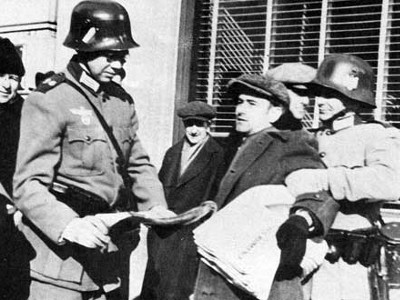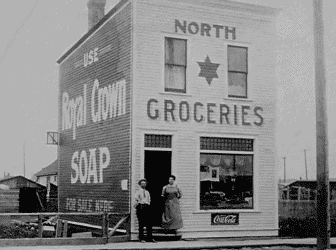
 Winnipeg Nazis? Remember the day a fake Nazi army invaded Winnipeg? It’s all right, hardly anyone does remember the Winnipeg Nazis, and it happened for a good cause.
Winnipeg Nazis? Remember the day a fake Nazi army invaded Winnipeg? It’s all right, hardly anyone does remember the Winnipeg Nazis, and it happened for a good cause.
On February 19, 1942, in temperatures hovering around minus 25 degrees Celsius, a mock Nazi invasion of Winnipeg and surrounding towns was staged, with air raid sirens blaring at 6:00 in the morning accompanied by 3,500 Nazi troops riding in armed convoys down the streets of the city.
By mid-morning, the Nazis had arrested Mayor John Queen, and then headed to the legislature, where they arrested Premier Bracken, seven of his ministers, as well as the Lieutenant Governor, hauling them all to be imprisoned at Lower Fort Garry.
The Union Jack was replaced with a Nazi flag and before lunch Winnipeg had been renamed Himmlerstadt.
The Nazis were played by, rather enthusiastically if the newsreel footage is anything to go by, the members of Winnipeg’s Junior Board of Trade.
The fake Nazi army then spent the day dragging books out of the Carnegie Library, which they burned outside. The Winnipeg Evening Tribune wrote, “They streaked into the building, emerged minutes later with great armloads of books and tossed them into the flames, with shouts of laughter.”
Winnipeg Nazis harassed random people and demanded ID…
They spent the rest of the day harassing random people in restaurants and on buses, demanding ID papers as they went, later parading their Bren gun carriers and troop transports up and down Portage Avenue.
Staged by the Victory Loan campaign, the fake takeover was called “If Day”, and was staged to prove a point about a reality that millions in Europe were already familiar with.
Rivaling Orson Welles’ “War of the Worlds” broadcast for sheer nerve and terror, the fake event succeeded in scaring people into buying war bonds.
Recently unearthed British Pathé newsreel footage proclaims, “Here’s an object lesson we can profit by, as well as Winnipeg.” Newsreels of the event were screened widely and were eventually watched by over 40 million people.
“If Day” raised $3,195,000 in Winnipeg, eventually bringing the province’s war bond total to $11,027,000.
Winnipeg’s first 200 Jews arrived in 1882, after the first exodus out of Russia in the wake of the assassination of Tsar Alexander II, an event for which Jewish people served as scapegoats.

The next wave of Jewish immigrants came after the 1905 revolution, with most settling in the city’s north end, around Jarvis Street and Stella, Dufferin and Flora, north of the CPR tracks, for which many were workers.
The Jews of Winnipeg, already radicalized from their time in Russia, played an active role in the Winnipeg General Strike of 1919.
It’s a little easy for us today to unthinkingly condemn the evils of Nazism, clear as they are in hindsight, and to laugh about the quaint scare tactics of “If Day”.
But Canadian attitudes towards the rise of Hitler during the 1930s were far from condemnatory.
In Toronto, many reputable social clubs and businesses unashamedly advertised for “gentiles only” and signs hung around local beaches that read “No Jews, Niggers, or Dogs.”
And while the Toronto Star’s European correspondent Matthew Halton began warning about the evils of Hitler as early as 1933, both the Globe & Mail and the Montreal Gazette wrote admiring editorials about Hitler, furthermore writing that widespread reports of the harassment of Jews in Germany were “imaginative lies”.
“Hitler was widely seen as a force for stability in Germany and as a bulwark against Communism,” said Halton’s son David during a recent radio interview.
Walter Lippmann, one of the most renowned American journalists of his day, famous for coining the terms “Cold War” and “Manufacture of Consent”, described Hitler as “the authentic voice of a great civilized people”.
In that sense, the editorial boards of the Globe and Mail and Montreal Gazette formed a sort of fifth column in Canada, along with the openly pro-Nazi Daily Mail in the U.K., who saw Hitler as a civilizing force.
Prime Minister Mackenzie King described Hitler, in his diary, as Germany’s “Joan of Arc”, lavishing praise on the Fuhrer. He would also refer to Neville Chamberlain as one of the greatest statesmen who ever lived, after his signing of the Munich agreement, and regarded Churchill’s condemnation of Chamberlain’s appeasement as the bellowings of a dangerous agitator.
So while the fantasy of “If Day” was effective in rallying sentiment against Hitler long after it had become clear that he was a menace, it’s worth remembering that Canadian attitudes in the lead-up to the war were mixed.
Leave a Reply
You must be logged in to post a comment.




 Share
Share Tweet
Tweet Share
Share




Comment